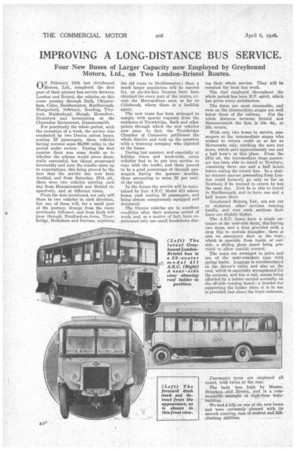IMPROVING A LONG-DISTANCE BUS SERVICE.
Page 26

If you've noticed an error in this article please click here to report it so we can fix it.
Four New Buses of Larger Capacity now Employed by Greyhound Motors, Ltd., on Two London-Bristol Routes.
ON February 10th last Greyhound Motors, Ltd., completed the first year of their pioneer bus service between London and Bristol, the vehicles on this route passing through Bath, Chippenham, Cake, Reckhampton, Marlborough, Bungerford, Newbury, Reading, Twyford, Maidenhead, Slough, nouns
law, Brentford and terminating at the Clarendon Restaurant, Hammersmith.
For practically the whole period, with the exception of a week, the service was conducted by two Dennis saloon buses, seating 23 passengers, these vehicles having covered some 86,000 miles in the period under review. During the first quarter there was some 'doubt as to whether the scheme would prove financially successful, but things progressed favourably and soon the results came up to expectations, this being proved by the fact that the service has now been doubled, and from Saturday, 27th ult., there were two vehicles starting each day from Elammersmith and Bristol respectively, and at different times.
From the date mentioned, not only will there be two vekieles in each direction, but one of these will, for a small part of the journey, diverge from the route previously followed, and from Bath will pass through Bradford-on-Avon, Trowbridge, Melksharo and Devizes, rejoining
the old route to Beckhamptort ; thus, -a much larger population will be catered for, as ply-for-hire licences have been obtained for every part of the routes, e-.7eept the Metropolitan area, so far as Colnbrook, where there is a booking agent.
The new route has been arranged to comply with special requests from the residents of Trowbridge, Bath and other points through which the new vehicles now pass. In fact, the Trowbridge Chamber of Commerce petitioned the whole district and took up the question with a tramway company who objected to the buses.
During last summer, and especially at holiday times and week-ends, extra vehicles bad to be put into service to cope with the traffic, and there proved to be a good percentage of through passengers during the Timmer months, these amounting to some 25 per cent. of the total.
In the future the service will be maintained by four A.E.C. Model 411 saloon buses, each seating 30 passengers, and being almost sumptuously equipped and decorated.
The Dennis vehicles are in excellent condition after their arduous period of work, and, as a matter of fact, have experienced only one small breakdown dur lug their whole service: They will be reseated for local bus work.
The fuel employed throughout the whole period has been B.F. spirit, which has given every. satisfaction.
The fares are most reasonable,. and even on the intermediate stages are well below those of the railway. For the whole distance between Bristol and Hammersmith the fare is 10s. 6d., or 20s. return.
With only two buses in service, passengers at the intermediate stages who wished to return could go so far as Morecambe only, catching the next bus down, which gave approximately one and a half hones at this place. From the 27th ult. the intermediate stage passenger has been able to travel to Newbury, remaining there. one and a half hours before taking the return bus. In a similar manner anyone preceeding from London could formerly go only so far as Newbury if he wanted to return by bus the same day. Now he is able to travel to Marlborough, and to have one and a half hours there.
Greyhound Motor Ltd., are not out to undercut other services running locally, and over such sections their fares are slightly higher.
The A.E.C. buses have a single entrance at the near-side front, this having two steps, and a door provided with a drop flap to exclude draughts ; 'there is also an emergency door at the rear, which is operable from inside or outside, a sliding glass panel being provided to allow outside control.
The seats are arranged in pairs and are of the semi-armchair type with spring backs. Luggage is accommodated in the driver's cabin and also on the roof, which is especially strengthened for the purpose, and has a rail, access being afforded by a ladder carried normally on the off-side run dug board ; a bracket for supporting the ladder when it is in use is provided just above the front entrance.
































